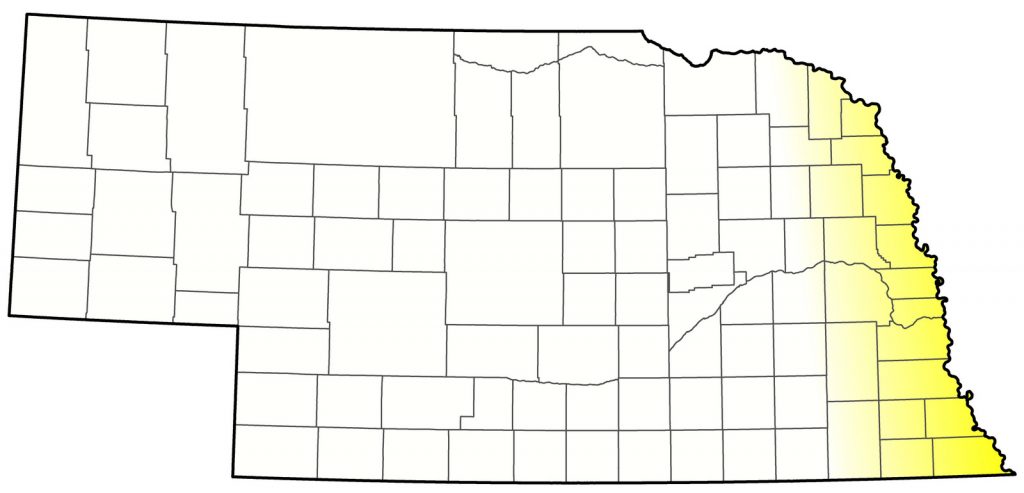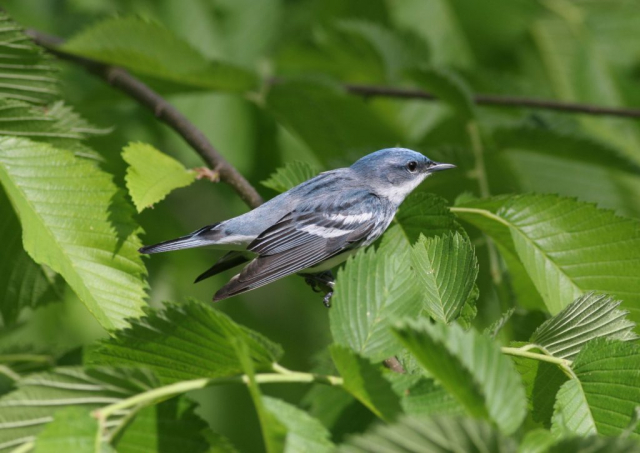Setophaga cerulea
Status: Rare regular spring migrant east, rare casual central and west. Rare casual summer visitor east. Rare casual fall migrant east.

Documentation: Specimen: UNSM ZM6860, 4 May 1901 Child’s Point, Sarpy Co.
Taxonomy: No subspecies are recognized (AviList 2025).
This species and Northern Parula (S. americana) are closely related, with similar plumage, song, and behavior, have hybridized, and been considered conspecific (Moldenhauer and Regelski 2020). An Iowa example of a hybrid is at eBird Checklist – 13 May 2017 – Wildcat Den SP. There are no Nebraska records of this hybrid, however. See Comments, below.
Spring: May 1, 1, 3 <<<>>> May 29, 30, Jun 1
An earlier date is 20-21 Apr 2023 Fontenelle Forest, Sarpy Co.
Nebraska is at the northwestern edge of the summer range, and so most sightings are from counties in the Missouri River Valley, north to Dixon Co. These records are considered here to be potential summer records and are discussed under Summer. There are very few records in counties away from the Missouri River, even in the east (see Summer): 7 May 2014 Wilderness Park, Lancaster Co, 8 May 2025 Grove Lake Road, Antelope Co, 9 May 2003 Wilderness Park, Lancaster Co, 11 May 2015 Platte River SP, Cass Co, 21 May 2016 female photographed at Conestoga Lake SRA, Lancaster Co, 24 May 2016 Walnut Grove Park, Douglas Co, 6 Jun 1997 Platte River SP, Cass Co (recording; Leger 1997), and 27 Jul 2006 Platte River SP, Cass Co.
The only documented records for the central and west are:
7 May 1999 Lake Ogallala, Keith Co (Brown and Brown 2001)
14-16 May 2005 male Scottsbluff, Scotts Bluff Co (Silcock 2005a)
29 May 2023 Phelps Co
6 Jun 1964 Sheridan Co specimen (Short 1965).
The Sheridan Co specimen was a male collected by Short (1965) along the Niobrara River near Rushville in Sheridan Co 6 Jun 1964; while this specimen had enlarged testes it was considered to be a migrant.
Summer: Cerulean Warbler has declined over most of its range (Robbins et al 1992), although while this decline is thought to be reflected more in numbers than geographic distribution (Buehler et al 2020), it appears to have slowly withdrawn from Nebraska as a breeding species from the early 1900s to the present. Bruner et al (1904) considered it a “rather common summer resident along the wooded bluffs of the Missouri River, where it breeds.” Mollhoff (2022) listed 3-4 nests with eggs and nestlings in Sarpy Co in 1900. Stephens (1937) noted collection of a male near Blyburg Lake, Dakota Co 14 May 1917. By the mid-20th Century Rapp et al (1958) classified it only as an uncommon “summer resident along the Missouri River.” Since 1900, however, nesting has been documented at only one site, Thomas Ashford Scout Ranch, Thurston Co. Reports from Ashford are of a singing male 8-15 Jun 1985 and 10 May 1990; a female was gathering nesting material there 17-18 May 1997, one of four birds present. There were other nesting records there during the 1980s and 1990s (Bill Huser, personal communication). The only record from Thomas Ashford Scout Ranch since was of a singing male 16 Jun 2001. It is interesting that during the 1990s there were reports of other southeastern species at Thomas Ashford Scout Ranch, including Acadian Flycatcher, Kentucky Warbler, and Louisiana Waterthrush, but the ranch was closed around 2014 and the property sold to private interests (Bill Huser, personal communication).
Silcock et al (2005b) reviewed the species’ status after conducting a survey in spring and summer 2004 in which only 5-7 singing males were estimated to be present in Nebraska; these were in Richardson, Sarpy, Douglas, and Washington Cos. Most years a few singing males are reported in May, usually at Fontenelle Forest and Indian Cave SP in Richardson Co. High count is a surprising five, albeit about 30 years ago at Fontenelle Forest, Sarpy Co 4 May 1992 (Grzybowski 1992). However, there were no accepted Jun-Jul records 2017-2019, only one in 2020, and none in 2021-2024. One was at Grove Lake, Antelope Co 8 May 2025.
Sites with multiple records since 2000 indicative of breeding but without documentation are Indian Cave SP, Richardson Co; Platte River SP, Cass Co, Fontenelle Forest, Sarpy Co; Hummel Park, Douglas Co; and Neale Woods, Douglas and Washington Cos.
At Indian Cave SP, reports are from the drainages in the southern part of the park in Richardson Co: two were present along Trail 9 on 6 Jun 1995, 1-2 on 28 May and 24 Jun 2001, 1 May 2003, 7 May and 9 Jul 2006, one 27 May-6 Jun 2012, 19 May 2014, a singing male 15 May 2015, 11 May 2015, and 11 May 2021.
Three reports from Platte River SP suggest potential breeding there: 11 May 2015, 6 Jun 1997 (recording; Leger 1997), and 27 Jul 2006.
At Fontenelle Forest, one was reported 10 May 1978, and there were several records during the 1990s at the same time as those in Thurston Co (above): 14 Jun 1989, 15 May 1993, 20-30 May 1996. Additional Fontenelle Forest records are of one on 10 May 2004, 23 May 2010 (2), three were present 28 Apr-7 Jul 2011, 1-2 on 4-20 May 2012, 10 May 2014, and 3-4, including two females 3-15 May 2016.
The only female found in the 2004 survey (Silcock et al 2005b) was at Hummel Park in Douglas Co, where Cerulean Warblers were observed regularly during the 1990s; however, no evidence of breeding was noted in 2004. Two singing males were present 11 May 2002, and also 16-21 May 2004. Singles were at Hummel Park 1 Jun 2005 and 3 Jul 2006.
One was singing at Neale Woods, Douglas Co 28 Jun 2000, one was there 1 May 2001, and another was on River Trail, Krimlofski Tract, in extreme southeast Washington Co 5 and 9 May 2016. One was at Fort Atkinson, Washington Co 10 May 1995. One was at Mercer Woods, Omaha, Douglas Co 25 May 2016.
Additional reports from northerly Missouri River Valley counties at sites where breeding may occur are 9 May 2021 Cuming Co, 13 May 2006 singing male near Newcastle, Dixon Co, and 24 May 2020 Ponca SP, Dixon Co.
Fall: There are no documented records after Jul and only these reported dates: 28 Aug, 3 Sep, 4 Sep, and 19 Sep 2010, all in Omaha, Douglas Co. We consider a report of a very late immature in Dixon Co 24 Oct 2011 to be equivocal; the report was received but not considered by NOURC (Brogie 2012). Away from the Missouri River Valley there are no documented reports.
Comments: As Cerulean Warbler has declined in Nebraska in recent years, doubt has been raised by Justin Rink (personal communication) that heard only singers identified as Ceruleans at Indian Cave SP may in fact be Northern Parulas; all “odd” singers heard personally by Rink that might have been Ceruleans were tracked down and found to be Northern Parulas. Some or perhaps all of these “odd” songs may be an alternate Northern Parula song that Pieplow (2017) describes as a “second-category song”. This frequently heard two-part Northern Parula song consists of buzzy series of notes with the initial series lower in pitch than the succeeding series so sounds quite similar to a Cerulean’s song (Shari Schwartz, personal communication, eBird.org). On the other hand, “odd” songs do occur; a visually identified Cerulean Warbler, whose song consisted of a series of paired buzzes on the same pitch, was seen and heard in the same place at Indian Cave SP for two consecutive springs 2004 and 2005 (Paul Lehman, Ross Silcock; Silcock et al 2005).
Images
Abbreviations
NOURC: Nebraska Ornithologists’ Union Records Committee
SP: State Park
SRA: State Recreation Area
UNSM: University of Nebraska State Museum
Literature Cited
AviList Core Team, 2025. AviList: The Global Avian Checklist, v2025. https://doi.org/10.2173/avilist.v2025.Brogie, M.A. 2012. 2011 (23rd) Report of the NOU Records Committee. NBR 80: 112-122.
Brown, C.R., and M.B. Brown. 2001. Birds of the Cedar Point Biological Station. Occasional Papers of the Cedar Point Biological Station, No. 1.
Bruner, L., R.H. Wolcott, and M.H. Swenk. 1904. A preliminary review of the birds of Nebraska, with synopses. Klopp and Bartlett, Omaha, Nebraska, USA.
Buehler, D.A., P.B. Hamel, and T. Boves. 2020. Cerulean Warbler (Setophaga cerulea), version 1.0. In Birds of the World (A. F. Poole, Editor). Cornell Lab of Ornithology, Ithaca, NY, USA. https://doi.org/10.2173/bow.cerwar.01.
Grzybowski, J.A. 1992. Southern Great Plains Region. American Birds 46: 443-446.
Leger, D. 1997. Checklist S44323882: Platte River State Park, Cass County, Nebraska US. eBird.org, accessed 23 Jun 2018.
Moldenhauer, R.R., and D.J. Regelski. 2020. Northern Parula (Setophaga americana), version 1.0. In Birds of the World (A. F. Poole, Editor). Cornell Lab of Ornithology, Ithaca, NY, USA. https://doi.org/10.2173/bow.norpar.01.
Mollhoff, W.J. 2022. Nest records of Nebraska birds. Nebraska Ornithologists’ Union Occasional Paper Number 9.
Pieplow, N. 2017. Peterson Field Guide to Bird Sounds of Eastern North America. Harper Collins.
Pyle, P. 1997. Identification Guide to North American Birds. Part I, Columbidae to Ploceidae. Slate Creek Press, Bolinas, California, USA.
Rapp, W.F. Jr., J.L.C. Rapp, H.E. Baumgarten, and R.A. Moser. 1958. Revised checklist of Nebraska birds. Occasional Papers 5, Nebraska Ornithologists’ Union, Crete, Nebraska, USA.
Robbins, C.S., J.W. Fitzpatrick, and P.B. Hamel. 1992. A warbler in trouble: Dendroica cerulea. Smithsonian Institution Press, Washington, D.C., USA.
Short, L.L., Jr. 1965. Bird records from northern Nebraska during the breeding season. NBR 33: 2-5.
Silcock, W.R. 2005a. Spring Field Report, March-May 2005. NBR 73: 46-67.
Silcock, W.R., J.J. Dinan, B. Huser, and J.G. Jorgensen. 2005b. Status of the Cerulean Warbler (Dendroica cerulea) in Nebraska. NBR 73: 124-130.
Stephens, T.C. 1937. The Birds of Dakota County, Nebraska. The American Midland Naturalist 18: 373-397.
Recommended Citation
Silcock, W.R., and J.G. Jorgensen. 2025. Cerulean Warbler (Setophaga cerulea). In Birds of Nebraska — Online. www.BirdsofNebraska.org
Birds of Nebraska – Online
Updated 23 Jul 2025

